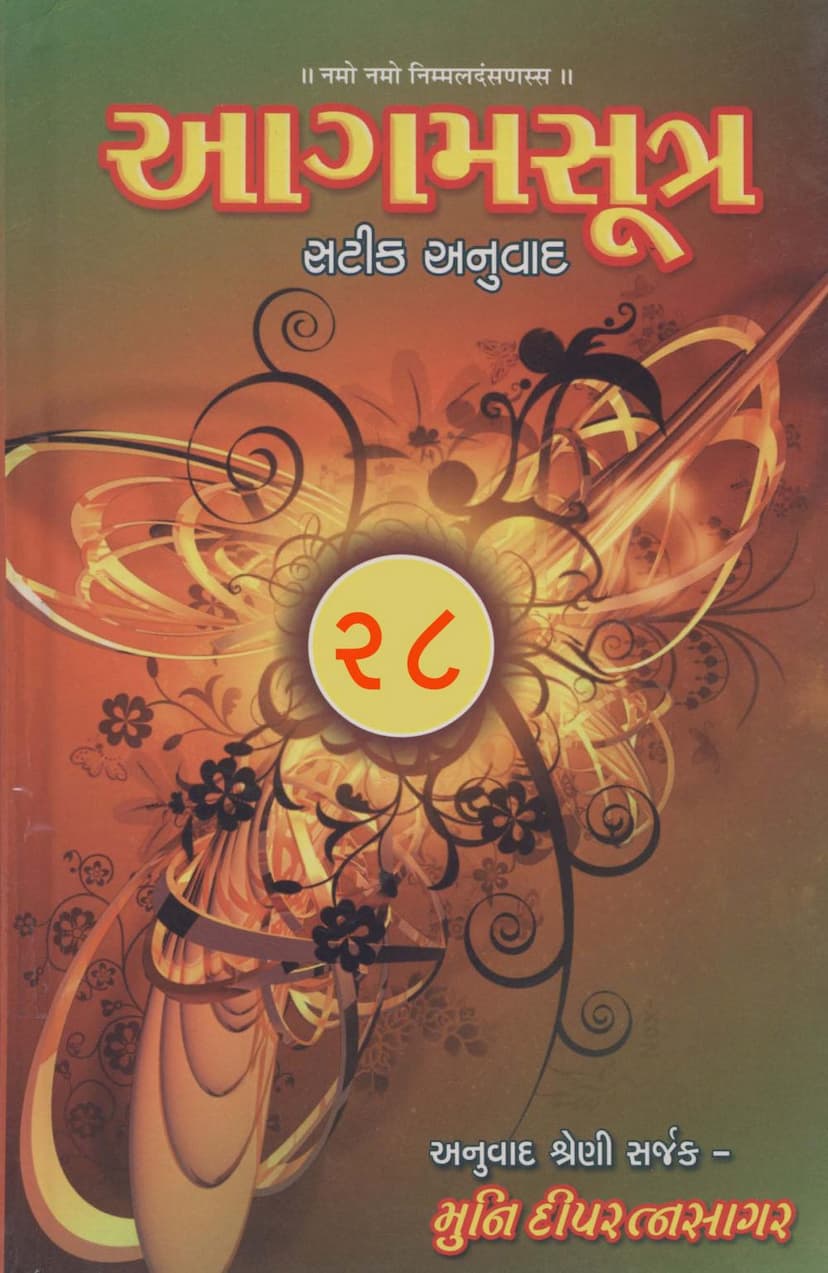Agam 29 Sanstaraka Sutra Satik Gujarati Anuvad
Added to library: September 1, 2025

Summary
This is a comprehensive summary of the Jain text "Agam 29 Sanstaraka Sutra Satik Gujarati Anuvad," based on the provided pages. The text is a Gujarati translation with commentary of the Sanstaraka Sutra, which is part of the Jain Agamas.
Overview of the Publication:
The provided pages are from a larger series titled "Agam Satik Anuvad" (Agam with Commentary Translation), published by Deepratnasagar and created by Muni Diperatnasagar. This specific volume is part of a larger project that aims to translate and provide commentary for all the Jain Agamas. The publisher acknowledges the significant financial and spiritual support received from various Jain sanghs and individuals for this monumental task.
Content of the Provided Pages:
- Title and Author: The title is "Agam 29 Sanstaraka Sutra Satik Gujarati Anuvad." The author/translator is Muni Diperatnasagar. The publisher is Deepratnasagar.
- Dedication and Salutations: The work begins with salutations to the Tirthankaras and revered Jain scholars. It expresses deep respect and gratitude to their spiritual gurus.
- Acknowledgement of Support: Several pages are dedicated to acknowledging the generous financial contributions from various Jain communities and trusts that made this publication possible. This highlights the collaborative effort involved in preserving and disseminating Jain scriptures.
- Publisher's Other Works: A significant portion of the document (Pages 8-15) lists and describes the extensive range of other publications by the same publisher, Muni Diperatnasagar. These include:
- Original Agam texts (Mul)
- Gujarati translations of Agams
- Commented Gujarati translations (Satik) of Agams (the main focus of this document)
- Agam dictionaries (Agam Kosh)
- Agam name dictionaries
- Hindi translations of Agams
- Compilations of stories and narratives from the Agams (Agam Katha Nuriyog)
- Rituals and guides for Jain ceremonies (Agam Matajan Vidhi, Pujya Vidhi Sangrah)
- Grammar literature, commentary literature, Tattva Abhyas literature, Aradhana literature, Viddhi literature, Pujana literature, Yantra literature, Jinabhakti literature, and miscellaneous literature.
- This extensive list demonstrates a deep commitment to making Jain scriptures accessible in various forms and languages.
- Summary of the Sanstaraka Sutra (Agam 29):
- Title: Sanstaraka Prakirnak Sutra (which is part of Agam 29).
- Commentary: The translation is based on the commentary (Vritti) by Guna Ratnasuri. The text notes that the received commentary was incomplete or fragmented, but it has been published with the available material and necessary explanations.
- Core Theme: The Sanstaraka Sutra deals with the concept of Sansthara (or Santhara), a ritualistic fasting to the death, a voluntary fast unto death undertaken by devout Jains, especially ascetics, in their final days. This practice is considered a pinnacle of spiritual discipline and detachment.
- Key Concepts and Themes Discussed in the Sutra (based on the verses and commentaries):
- Significance of Sansthara: The Sansthara is presented as a highly auspicious and meritorious act, a culmination of all other spiritual practices. It is described as a path to liberation, a means to shed karma, and a source of immense spiritual merit.
- Comparison and Superiority: The Sansthara is compared to various precious elements and actions to emphasize its supreme value. It is likened to the precious gems in jewels, the scent of sandalwood, the strength of a lion, and the supreme happiness of liberation.
- Qualities of the Practitioner: The verses describe the ideal practitioner as one who is free from attachment, ego, and desires. They are virtuous, disciplined, knowledge-seeking, and detached from the body. They have a pure intention and follow the teachings of the Tirthankaras.
- Examples of Renunciation and Sacrifice: The text provides numerous examples of Jain saints and ascetics who endured extreme suffering, physical torment, and even death with equanimity and detachment while observing the Sansthara or similar practices. These include examples of being eaten by animals, burned, pierced, or drowned, yet maintaining their spiritual resolve and achieving liberation.
- Detachment from the Body: A central theme is the understanding that the soul is distinct from the body. The practitioner cultivates detachment from the physical self, seeing the body as a temporary vessel.
- Karma and Liberation: The Sansthara is depicted as a powerful means to accelerate the shedding of accumulated karma, leading to liberation from the cycle of birth and death.
- Spiritual Discipline: The practice involves rigorous adherence to vows, austerities, meditation, and detachment. It is highlighted as a path to supreme spiritual attainment.
- The Role of Right Knowledge and Conduct: The verses emphasize the importance of Samyak Jnana (right knowledge) and Samyak Darshana (right faith) as foundational for undertaking the Sansthara.
- The Concept of "Uttamaarth": This term refers to the ultimate goal, liberation, which is achieved through such arduous spiritual practices.
- Communal Harmony and Forgiveness: The text also includes verses where the practitioner seeks forgiveness from the entire Jain community (Sangh) and all living beings, demonstrating humility and a desire for universal well-being before their ultimate departure.
Overall Purpose:
The publication of "Agam 29 Sanstaraka Sutra Satik Gujarati Anuvad" aims to make this important Jain scripture accessible to Gujarati-speaking readers. It provides not only the literal translation of the verses but also the commentary, offering a deeper understanding of the profound spiritual principles and practices discussed, particularly the significance of Sansthara in Jainism. The extensive list of other publications signifies the publisher's dedication to promoting Jain knowledge across a wide spectrum of subjects.